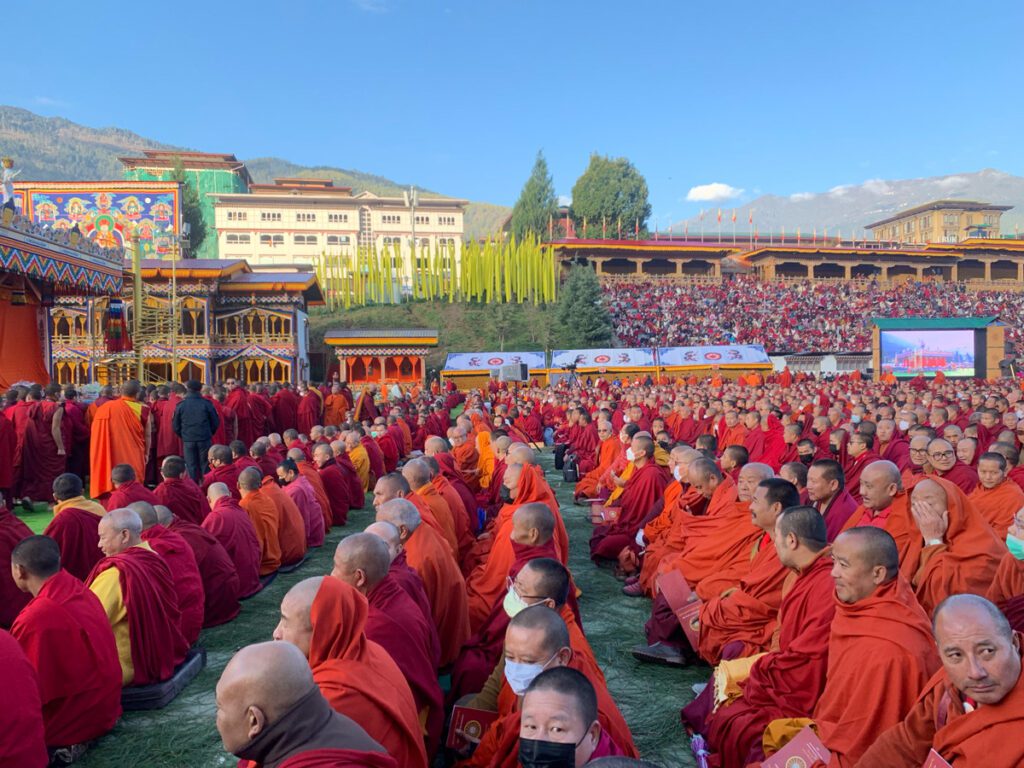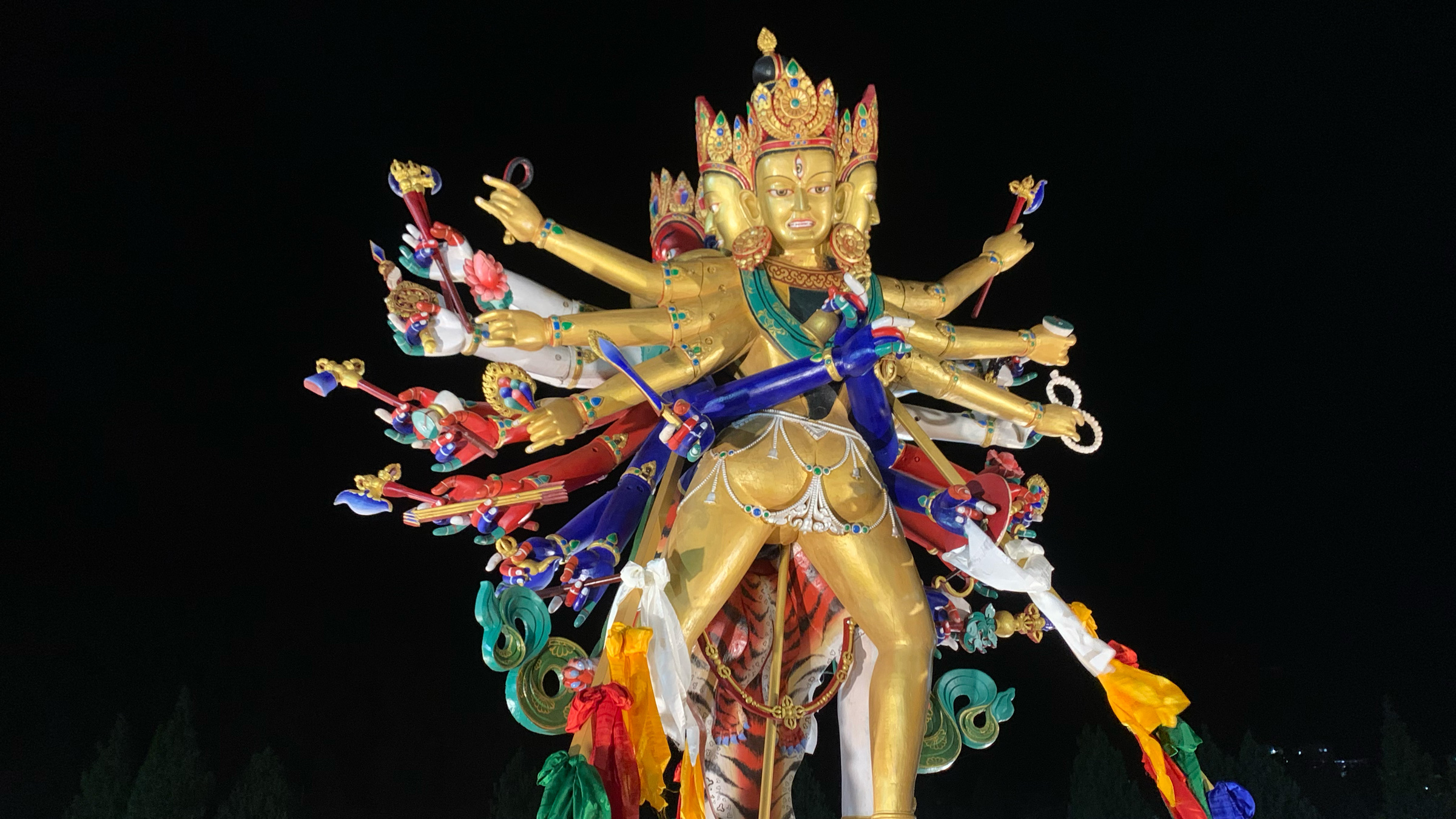Crowds cluster around the gates of Bhutan’s national stadium, begging to be let in. But the gates are locked. At just 7 am, the stadium is already full, and security guards worry that if they admit more people, someone will get injured.
This is the first day of the Kalachakra empowerment, a centerpiece of the inaugural Global Peace Prayer Festival, held in Thimphu, Bhutan, from November 4–19, and apparently everyone from all over the country—and from well beyond it—wants to be here. Tens of thousands are in attendance. Even India’s Prime Minister, Narendra Modi, is on his way.
Kalachakra initiations or empowerments are not offered regularly, and in Bhutan it’s downright rare. This particular Kalachakra is especially historic because not only are eminent Vajrayana Buddhist teachers participating but also teachers from the Theravada and Mahayana traditions. Plus, in these times of polarization and global unrest, it seems like a particular potent moment for the Kalachakra. After all, it is believed to promote inner and outer peace, planting seeds of global harmony and healing.
Sporting a press pass, I linger near where the monks are sitting. A sea of burgundy, orange, and saffron robes, they directly face the sumptuous pavilion where the ceremonies will take place.
In pride of place on the bottom floor of the pavilion, there is a Kalachakra sand mandala. Then, up the yellow spiral staircase to the top, there is a yab-yum statue presiding over the space: two figures in sexual union. With its many faces and arms, this statue is hand-carved of wood, gleaming gold, and set to slowly spin.
Me? My mind is spinning. What is the meaning of the Kalachakra?

Roger Jackson, coauthor of The Wheel of Time: The Kalachakra in Context, agrees to take an emergency Zoom call to answer my questions. Since the Kalachakra is part of the larger tantric tradition, first we need to cover tantra 101.
“The key feature of tantra,” Jackson says, “is taking the goal, which is buddhahood, and making it the path. You dissolve or deconstruct your ordinary sense of yourself as a person, and you reconstruct yourself as a buddha/deity. You see your body in the form of a buddha. Your speech is, in effect, mantra—sacred speech. Your environment is a mandala, the sacred environs of a buddha, and your mind is the mind that recognizes the actual nature of things. Some people have described tantra as a kind of dress rehearsal for enlightenment, because even though you’re not really a buddha, you’re taking on the identity of a buddha.”
Essentially, Jackson continues, “tantra is about transformation.” In this, there are two stages: generation (or creation) and completion (or perfection). The generation stage is the transformation of seeing, that is you overcome ordinary appearances. You see things purely, and you see them as pure. Then in the completion stage, you have a direct realization of emptiness, and you transform your mind and body into the mind of buddha. This is a transformation of being.
But in order to practice tantra, you have to be initiated or empowered. This is an absolute prerequisite because, as one lama once put it, the thing about tantra is that it can take you straight to heaven—because it’s this dramatic, direct approach—but if you mess up, tantra will take you straight to hell.
If you’re unprepared, the wrathful deities and sexual imagery can be easily misunderstood, and visualizing yourself as deity can lead to delusion. “So, you don’t want to mess with it,” says Jackson. “That’s why initiation is required, and why initiation, in turn, requires that you find a proper guru or teacher who is himself or herself experienced in this system and can judge your fitness as a disciple.”

There are many tantric systems. But the Kalachakra, which dates back to the eleventh century, was one of the last of the major tantric systems to develop in India. Most of the major tantras have four initiations, or ritual ceremonies, but the Kalachakra is more complex with eleven initiations, including the water initiation during which water is sprinkled on the disciples as a symbolic purification, and the crown initiation during which a crown is placed on the disciples’ heads to represent their potential to attain buddhahood.
Generally, only the first seven of the Kalachakra initiations are given publicly—the remaining four are too advanced for the general population. In fact, the Kalachakra is unusual in that any of it offered publicly. The Dalai Lama has brought international attention to this empowerment by offering it to large crowds. In 2012, for example, over 200,000 people attended the Kalachakra initiation he officiated in Bodhgaya, India. Notably, he was also the first to confer it in North America, which he did in 1981 in Madison, Wisconsin.
The word Kalachakra means “wheel of time” or “time cycles.” In essence, the Kalachakra tantra is about cyclic existence—the continual coming into being, eventual dying or disintegrating, and then coming into being again in new form. Everything from a single breath to a human life to the cosmos itself is subject to this cycle, but the Kalachakra is about how to get free of it and become a buddha.

The buddhas at the heart of this tantra are Kalachakra and Vishvamata whose statue is on top of the central pavilion. While their sexual union might be shocking to some, the intention, says Kalachakra translator Niraj Kumar is to “depict the nondual union of everything in the universe.”
No separation. No us, no them. No birth, no death.
I take one more up-close look at the Kalachakra statue spinning in place under the blue sky of Bhutan. The whole scene is glorious: Mountains rest calmly in the distance. Prayer flags whip in the wind. Incense burns.
Then a security guard ushers me out of the area for monastics, and I weave my way through the stadium, trying to find a place to sit. Finally, I find a viewing pavilion where I have clear slight of an enormous screen that shows what’s happening on the red carpet: the King of Bhutan entering with his father.
The woman sitting on my right offers me a cup of butter tea. Actually, she says, it doesn’t have butter in it. She needs to avoid butter for her cholesterol. I gladly accept. I also should avoid butter for my cholesterol. And I’m hungry since I skipped breakfast, so I’m truly grateful when she gives me zoaw, puffed rice, which she has mixed with cornflakes. We throw the zoaw into our teacups, and it’s almost like being back home, having breakfast cereal.
Sitting on my right there’s a little boy, maybe eight years old, who’s wearing glasses and watching something on a phone. Since I really want to experience the profundity of the Kalachakra, I’m a little put out by his noisy show. Then I notice he’s watching videos about Minecraft and immediately I think of my own little boy half way around the world. He also wears glasses, loves playing with a phone, and is crazy about Minecraft.
Suddenly, I’m not bothered, because in a sense the Kalachaka is doing just what it is supposed to do: It is bringing people together, shining a light on our oneness. This empowerment, I realize, is not a magic spell for global harmony. It is a way to formalize our aspiration for peace, and—as with every endeavor—aspiration is the necessary and powerful first step.
I hand the empty teacup back to the woman beside me. Thank you, I say.
Lion’s Roar readers curious about travel to Bhutan might also be interested our March 2026 pilgrimage. Participants will meditate in ancient monasteries, explore sacred sites, and immerse themselves in the spiritual heart of the Himalayas.

